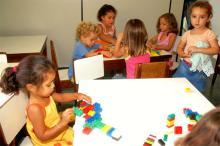
Child-centered, play-based learning is a whole-child educational approach that promotes academic, socio-emotional, and cognitive development through free play, which can also involve guided play by an adult. In guided play, teachers enhance children’s exploration and learning with helpful guidance while being careful not to be invasive in the children’s play.1 Play-based learning has been described as developmentally appropriate learning for young children, where children learn at their own pace through the natural process of play.2
A play-based learning environment for children contains many stimulating opportunities for play that include dramatic play props and dress-up clothes, blocks, toys, and loose parts, art materials, musical instruments, books, and writing implements. These play things allow for open-ended play and experimentation and an imaginative expression of ideas that are key to a child’s understanding of his world.3
In a classroom that supports play-based learning the children are given opportunities to engage in unstructured child-centered free play. As the teacher observes an activity that is holding the children’s interest, she then can plan her teaching by building play experiences that will incorporate her standards-based goals and objectives in a playful and stimulating setting. By taking advantage of the highly engaging nature of the children’s play, the introduction of math, science, language, and literacy concepts can then be taught in a subtle, but meaningful context.4 The goal of a play-based curriculum is to foster in children a love of discovery and exploration, encourage curiosity, and develop a desire for lifelong learning.
In a play-based classroom, opportunities to learn about reading, writing, and math are introduced through real, meaningful situations rather than traditional classroom instruction. This helps the children think abstractly by experiencing real objects using their senses. A necessary pre-requisite to understanding print and literacy concepts can be achieved through symbolic play with concrete objects seen as symbols. Important math concepts can be internalized by the sorting, categorizing, putting items in a series, and other problem-solving tasks created in play.5 Make-believe play helps young children “expand vocabulary and link objects with actions, develop object constancy, form event schemas and scripts, learn strategies for problem solving, develop divergent thinking ability, and develop a flexibility in shifting between different types of thought.”6
Creativity and problem-solving abilities are enhanced by playful learning. Professionals in scientific fields, such as computer science, physics, engineering, mathematics, and others, stress the value of playful learning to promote curiosity, innovation, and thinking outside of the box.7
Many educators and play theorists have been proponents of play-based learning in classroom settings for years. Maria Montessori observed that children concentrated most effectively when they were interested in the activity and that they are intrinsically motivated to learn.8 Montessori classrooms and Waldorf Schools both promote stimulating environments that allow for incorporating learning with play.
There has been a shift in early childhood classrooms to adult-directed, instruction-based philosophies to meet the demands for focusing on the achievement of functional skills, such as pre-literacy and mathematics, of young children before they may be developmentally ready. Time for play in kindergartens has been replaced with desk work, and even recess has often been reduced in an effort to meet classroom standards determined by school administrators.9 Many experts believe that the increased reports of behavior problems with the rise in anger and aggression in young children point to the lack of play opportunities and inappropriate expectations of academic standards.10
There is concern that the standardized curriculum and high-stakes testing in most elementary schools discourages the opportunities for play-based learning, which in turn could negatively affect the future workforce. Skepticism about the value of play has led to the prevailing thought that children should be taught at earlier ages the basic elements of reading with phonics and letter recognition to promote success in school. However, recent research has shown that the play-based approach produces equally good or better results in reading and other intellectual skills than those denied play and are more likely to result in well-adjusted healthy people.11
- 1. Fisher, Kelly, Kathy Hirsh-Pasek, Roberta M. Golinkoff, Dorothy G. Singer, and Laura Berk. “Playing around in School: Implications for Learning and Educational Policy.” In A. Pellegrini (ed.). The Oxford Handbook of Play. NY:Oxford University Press, pp. 341-363.
- 2. Oliver, Susan J. and Edgar Klugman. “Speaking Out for Play-Based Learning. Becoming an Effective Advocate for Play in the Early Childhood Classroom.” Child Care Information Exchange. January/February 2004. pp. 22-25. < http://web.mac.com/sharondeleon/FC/CDES_115_files/speaking_out_for_playbase.pdf > 19 Oct. 2011.
- 3. Frost, Joe L., Sue Wortham, Stuart Reifel. Play and Child Development. Upper Saddle River, NJ: Prentice-Hall, Inc., 2001. pp. 298-300.
- 4. Hoisington, Cynthia. “Let’s Play! Using Play-Based Curriculum to Support Children’s Learning throughout the Domains.” Earlychildhood NEWS. < http://www.earlychildhoodnews.com/earlychildhood/article_view.aspx?ArticleID=453 > 19 Oct. 2011.
- 5. Grossman, Sue. “The Worksheet Dilemma: Benefits of Play-Based Curricula.” Earlychildhood NEWS. < http://www.earlychildhoodnews.com/earlychildhood/article_view.aspx?ArticleID=134 > 19 Oct. 2011.
- 6. Singer, Dorothy G., Jerome L. Singer, Heidi D’Agostino, and Raeka DeLong. “Children’s Pastimes and Play in Sixteen Nations. Is Free-Play Declining?” American Journal of Play. Winter 2009. Volume 1 Number 3. p. 286.
- 7. Bergen, Doris. “Play as the Learning Medium for Future Scientists, Mathematicians, and Engineers.” American Journal of Play. Spring 2009. Volume 1 Number 4. pp. 413-425.
- 8. “An Inroduction to Montessori Philosophy & Practice.” The Michael Olaf Montessori Company. < http://www.michaelolaf.net/1CW312MI.html > 4 Aug. 2011.
- 9. Op. cit., Oliver and Klugman.
- 10. Miller, Edward and Joan Almon. “Summary and Recommendations of Crisis in the Kindergarten. Why Children Need to Play in School.” Alliance for Childhood. < http://www.allianceforchildhood.org/sites/allianceforchildhood.org/files/file/Kindergarten_8-page_summary.pdf > 19 Oct. 2011.
- 11. Ibid.

